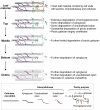The dynamics of plant cell-wall polysaccharide decomposition in leaf-cutting ant fungus gardens
- PMID: 21423735
- PMCID: PMC3053354
- DOI: 10.1371/journal.pone.0017506
The dynamics of plant cell-wall polysaccharide decomposition in leaf-cutting ant fungus gardens
Abstract
The degradation of live plant biomass in fungus gardens of leaf-cutting ants is poorly characterised but fundamental for understanding the mutual advantages and efficiency of this obligate nutritional symbiosis. Controversies about the extent to which the garden-symbiont Leucocoprinus gongylophorus degrades cellulose have hampered our understanding of the selection forces that induced large scale herbivory and of the ensuing ecological footprint of these ants. Here we use a recently established technique, based on polysaccharide microarrays probed with antibodies and carbohydrate binding modules, to map the occurrence of cell wall polymers in consecutive sections of the fungus garden of the leaf-cutting ant Acromyrmex echinatior. We show that pectin, xyloglucan and some xylan epitopes are degraded, whereas more highly substituted xylan and cellulose epitopes remain as residuals in the waste material that the ants remove from their fungus garden. These results demonstrate that biomass entering leaf-cutting ant fungus gardens is only partially utilized and explain why disproportionally large amounts of plant material are needed to sustain colony growth. They also explain why substantial communities of microbial and invertebrate symbionts have evolved associations with the dump material from leaf-cutting ant nests, to exploit decomposition niches that the ant garden-fungus does not utilize. Our approach thus provides detailed insight into the nutritional benefits and shortcomings associated with fungus-farming in ants.
Conflict of interest statement
Figures




Similar articles
-
Ant mediated redistribution of a xyloglucanase enzyme in fungus gardens of Acromyrmex echinatior.BMC Microbiol. 2016 May 6;16:81. doi: 10.1186/s12866-016-0697-4. BMC Microbiol. 2016. PMID: 27154066 Free PMC article.
-
The fungal symbiont of Acromyrmex leaf-cutting ants expresses the full spectrum of genes to degrade cellulose and other plant cell wall polysaccharides.BMC Genomics. 2013 Dec 28;14:928. doi: 10.1186/1471-2164-14-928. BMC Genomics. 2013. PMID: 24373541 Free PMC article.
-
Leaf-cutting ant fungi produce cell wall degrading pectinase complexes reminiscent of phytopathogenic fungi.BMC Biol. 2010 Dec 31;8:156. doi: 10.1186/1741-7007-8-156. BMC Biol. 2010. PMID: 21194476 Free PMC article.
-
The prominent role of fungi and fungal enzymes in the ant-fungus biomass conversion symbiosis.Appl Microbiol Biotechnol. 2014 Jun;98(11):4839-51. doi: 10.1007/s00253-014-5708-5. Epub 2014 Apr 15. Appl Microbiol Biotechnol. 2014. PMID: 24728757 Review.
-
The origin of the attine ant-fungus mutualism.Q Rev Biol. 2001 Jun;76(2):169-97. doi: 10.1086/393867. Q Rev Biol. 2001. PMID: 11409051 Review.
Cited by
-
Disentangling nutritional pathways linking leafcutter ants and their co-evolved fungal symbionts using stable isotopes.Ecology. 2018 Sep;99(9):1999-2009. doi: 10.1002/ecy.2431. Epub 2018 Aug 1. Ecology. 2018. PMID: 30067862 Free PMC article.
-
A fungal symbiont converts provisioned cellulose into edible yield for its leafcutter ant farmers.Biol Lett. 2022 Apr;18(4):20220022. doi: 10.1098/rsbl.2022.0022. Epub 2022 Apr 20. Biol Lett. 2022. PMID: 35440234 Free PMC article.
-
Ant mediated redistribution of a xyloglucanase enzyme in fungus gardens of Acromyrmex echinatior.BMC Microbiol. 2016 May 6;16:81. doi: 10.1186/s12866-016-0697-4. BMC Microbiol. 2016. PMID: 27154066 Free PMC article.
-
Understanding plant cell-wall remodelling during the symbiotic interaction between Tuber melanosporum and Corylus avellana using a carbohydrate microarray.Planta. 2016 Aug;244(2):347-59. doi: 10.1007/s00425-016-2507-5. Epub 2016 Apr 12. Planta. 2016. PMID: 27072675
-
Laccase detoxification mediates the nutritional alliance between leaf-cutting ants and fungus-garden symbionts.Proc Natl Acad Sci U S A. 2013 Jan 8;110(2):583-7. doi: 10.1073/pnas.1212709110. Epub 2012 Dec 24. Proc Natl Acad Sci U S A. 2013. PMID: 23267060 Free PMC article.
References
-
- Hölldobler B, Wilson EO. Cambridge: Harvard University Press; 1990. The Ants.
-
- De Fine Licht HH, Boomsma JJ. Forage collection, substrate preparation and diet composition in fungus-growing ants. Ecol Entomol. 2010;35:259–269.
-
- Pauly M, Keegstra K. Cell-wall carbohydrates and their modification as a resource for biofuels. The Plant J. 2008;54:559–568. - PubMed
-
- Mueller UG, Schultz TR, Currie CR, Adams RMM, Malloch D. The origin of the attine ant-fungus mutualism. Quart Rev Biol. 2001;76:169–197. - PubMed
Publication types
MeSH terms
Substances
LinkOut - more resources
Full Text Sources
Medical

